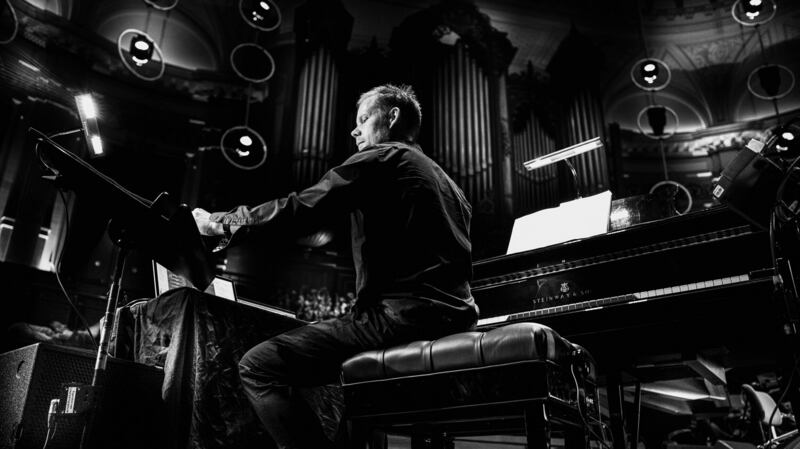Released in 2015, Max Richter’s Sleep – mellow nocturnal composed for piano, cello, two violas, two violins, organ, soprano vocals, synthesizers and electronics – was created with help from neuroscientist David Eagleman with the aim of sustaining and soothing the sleeping brain.
Speaking via Zoom from the home he shares with his long-term creative partner, the BAFTA winning filmmaker, and Sleep’s co-architect, Yulia Mahr, the British-German composer outlines the differences between his landmark work and what he calls “sonic wallpaper”.
“The music, from a technical standpoint, is listening music in the sense that if you listen to it you can relate to a musical argument and musical grammar,” says Richter. “Although it’s an argument that is taking place over a huge timespan so it’s got a very unusual texture. But it is a musical object rather than just a sound object.
“It’s an artwork and it’s an artwork which is asking the question about mind and music connecting in this different space. There are all kinds of nerdy musical technical things going on under the hood which make it have the effect. It isn’t, for example, a drone work or an ambient work. It has a relationship to concert music and traditional composition.”
At 8.5 hours and comprising some 31 different low-frequency compositions, the entire album was performed on BBC3 in September 2015, becoming the longest live broadcast of a single musical composition in the history of the network.

No rules
Five years on and more than 350 million streams later, Sleep has spawned From Sleep, a one-hour edit designed to be listened to while awake, and a most effective sleeping app simply called Max Richter’s Sleep. The composer has used it for meditating but not, he admits, for slumber.
“I can’t sleep with music on. Ironically,” he says.
Mahr and Richter have subsequently staged Sleep in a variety of venues including the Sydney Opera House, Grand Park in Los Angeles, in Madrid at the Veranos de la Villa, Kraftwerk Berlin, in Helsinki with half of the audience in two-person tents, at the Philharmonie de Paris and at the Great Wall of China.
“There are no rules,” says Richter ahead of the Los Angeles performance. “Listen as you like. Sleep as you like. Maybe switch the phones off? And enjoy the trip.
“The Berlin shows were incredible because that building is incredible. Antwerp Cathedral was pretty amazing. Sydney was great. We’ve been really lucky. We’ve been to some amazing places and they’ve all been very special. We just realise that it was five years ago to the day that we released the album. And then we have the journey to get each of the performances made which was very difficult. It was almost impossible.”
And now, adding to the canon, there’s Max Richter’s Sleep, the movie. The documentary, directed by Emmy-nominated filmmaker Natalie Johns, is a fascinating portrait of Richter and Mahr’s process and home life, and the preparations for and the extraordinary responses to the 2018 open-air performance of Sleep in Los Angeles. The scale of the production is unfailingly daunting.
Pretty soon I realised that there's an incredible thing that happens when you start just drifting in and out of this dreamy space
“The thing about this big projects is that they do take years,” says Mahr. “And it’s great to be able to take years. Most artists don’t get that opportunity. But somehow with the way that we work, it allows us to spend a long time with projects. And you really start to see something different after a while. Albums are released. There is a big splash and then they’re gone. And no one really explores what is going on. But we’ve had that opportunity and it’s been a lovely process.”
That sense of deeper excavation has been enhanced, says the composer, by multiple live renditions.
“Over the years of performing I feel like I’ve come to know it better,” says Richter. “That sounds crazy because I wrote it but there’s something different about making that journey in real time rather than just making it in your head in an imagined way. Every performance is different and the audiences are different.
“You learn a lot each time. It’s funny because last year – or the year before – we played it quite a bit. And it was wonderful to become really familiar with the landscape of the piece because you’re trying to navigate it in real time as a performer which is very different from having written it. You are three hours in and you’re thinking: ‘Is it that bit that goes like this or is it the bit that goes like that?’ as you’re turning the page.
“When you’re tired and you’ve been playing for five are six hours your brain does go a bit crazy. But having done a lot of performances we did start to feel like we were able to play it in a way that was doing it justice.”
Streaming
Sleep was borne out of live streaming, performances in far-away time zones, and the tiredness that hits a parent who has been tending to three daughters all day.
“When we were younger we had small children and we had no money,” Mahr explains in the new documentary. “So of course when Max went away to do his concerts I could never go. I would stay behind. It was really lovely when people started streaming concerts because suddenly I could listen in. You feel nervous for your partner. You want it to go well. You’re interested in how it goes.
“You kind of want to be there. So that was my way of experiencing it. I’d be exhausted because I was with the kids all day. I’d be so tired I’d almost always fall asleep. And pretty soon I realised that there’s an incredible thing that happens when you start just drifting in and out of this dreamy space and these liminal spaces start to develop. You start to listen in a totally different way and it becomes a very emotional listening experience.
My own records and my own projects and ballets and whatever else; those are things that I do on my own terms
“So when Max would come back I talked to him about this. And I said we have to do something with this because this is an incredible thing. And he said: ‘well, it’s funny you should say that because here’s this piece I’ve been working on since 1995’.”
Natalie Johns’ film is almost as intimate as the performances of Sleep, or indeed, sleep itself. There are glimpses of Richter and Mahr’s family life and twilight walks at their Oxfordshire home.
They are both frank about their early financial struggles. Comfort, says Mahr, is a surprisingly recent development. (As of December 2019, Richter has passed one billion streams and one million album sales.)
“It was not very long ago,” she says. “Things are difficult in music. Since file sharing everything has changed, especially for composers, because a musician in a band can go out on tour. That’s the main income. But for a composer you have to be at home writing and it doesn’t really work in the same way. So it’s been really up-and-down for an awfully long time.”
“I mean there’s always an ebb and flow,” adds Richter. “I feel like – on a creative level – once we got Sleep to exist in the world, it was like drawing a line in the sand. It was a project that took many years and we realised it at the level that it needed to be. I feel pretty happy about that really.”
Own terms
Richter is an intriguing and often reactive talent. It’s impossible to think of another musician with a back catalogue that features Roni Size and Vilvaldi, Tilda Swinton reading Kafka and Robert Wyatt reading Haruki Murakami, Steve Reich and Future Sound of London, or Julia Wolfe and Kelli Ali.
Meanwhile, his scores for film and television, for projects as varied as The Leftovers, Black Mirror and Ad Astra, have brought his music to a much wider audience. Movie work is different, he says.
“My own records and my own projects and ballets and whatever else; those are things that I do on my own terms,” says Richter. “So in terms of the writing process, they’re quite freewheeling. Cinema and TV projects are a completely different thing.
“They are fundamentally team activities. It’s all about the conversations you have with the director or the editor or the cinematographer and whoever. And trying to discover how music can illuminate whatever else is going on in the world of that project.”
Sleep is now in cinemas and available digitally










